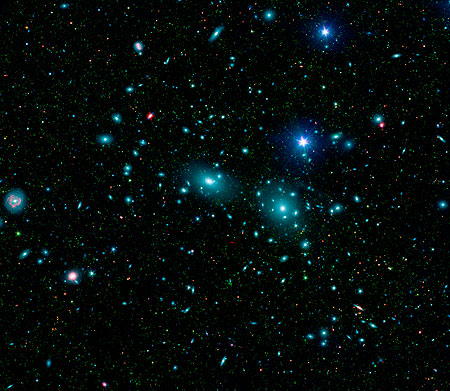Thousands of Dwarf Galaxies in the Coma Galaxy Cluster
ING web news release
27th June, 2007
Astronomers have been able to identify about 1600 dwarf galaxies in the Coma galaxy cluster, which
are likely to be either part of a population of low-surface-brightness dwarf galaxies or too red to be detected in the existing optical surveys.
The team found almost 30,000 objects in two selected fields of the Coma cluster using data from Spitzer Space Telescope. Then they measured hundreds of spectrocopic redshifts by using
AF2/WYFFOS multi-fibre spectrograph on the William Herschel Telescope. They estimate that a large fraction of the objects are actually dwarf galaxies and members of the cluster. If this result
is extrapolated to the whole cluster, at least 5000 cluster members must be dwarf galaxies.
Dwarf galaxies are important because they are considered as the building blocks for larger galaxies, and they are by far the most numerous in the Universe. Computer simulations of cosmic evolution suggest that high-density regions of the universe, such as giant clusters, should
contain significantly more dwarf galaxies than astronomers have observed to date.
 |
This false-color mosaic of the central region of the Coma cluster combines infrared and visible-light images to reveal thousands of faint objects (green). Follow-up spectroscopic observations with AF2/WYFFOS
showed that many of these objects, which appear here as faint green smudges, are dwarf galaxies belonging to the cluster. Two large elliptical galaxies, NGC 4889 and NGC 4874, dominate the cluster's center.
The mosaic combines visible-light data from the Sloan Digital Sky Survey (color coded blue) with long- and short-wavelength infrared views (red and green, respectively) from NASA's Spitzer Space Telescope.
Credit: NASA/JPL-Caltech/L. Jenkins (GSFC) [ JPEG | TIFF ]. |
More information:
- Jenkins, L. P.; Hornschemeier, A. E.; Mobasher, B.; Alexander, D. M.; Bauer, F. E., 2007, "Uncovering the Near-IR Dwarf Galaxy Population of the Coma Cluster with Spitzer IRAC", ApJ, accepted, astro-ph/0705.3681.
- Spitzer Nets Thousands of Galaxies in a Giant Cluster, Spitzer Space Telescope Press Release, 28th May 2007.
|
|



